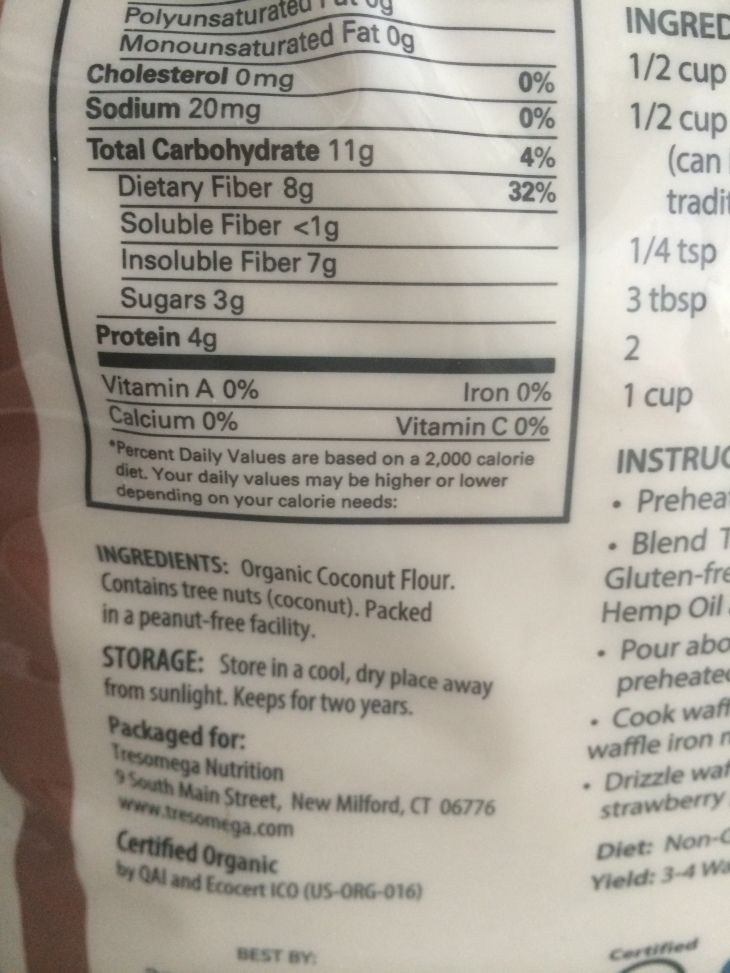Hi guys,
Make the switch today from bleached flour to organic coconut flour, you body will thank you.
Here is why: courtesy of http://en.wikipedia.org/wiki/Flour
Bleached flour
“Refined flour” has had the germ and bran removed and is typically referred to as “white flour”. “Bleached flour” is any refined flour with a whitening agent added.
Bleached flour is artificially aged using a bleaching agent, a maturing agent, or both. A bleaching agent would affect only the carotenoids in the flour; a maturing agent affects glutendevelopment. A maturing agent may either strengthen or weaken gluten development.
The four most common additives used as bleaching/maturing agents in the USA at this time are:
Potassiun bromate (will be listed as an ingredient/additive) – a maturing agent that strengthens gluten development. Does not bleach.
Benzoyl peroxide – bleaches. Does not act as a maturing agent – no effect on gluten
Ascorbic acid – (Will be listed as an ingredient/additive, but seeing it in the ingredient list may not be an indication that the flour was matured using ascorbic acid but instead has had a small amount added as a dough enhancer) – Maturing agent that strengthens gluten development. Does not bleach.
Chlorine gas – both a bleaching agent and a maturing agent, but one that weakens gluten development. Chlorination also oxidizes starches in the flour, making it easier for the flour to absorb water and swell, resulting in thicker batters and stiffer doughs. The retarded gluten formation is desirable in cakes, cookies, and biscuits as it would otherwise make them tougher and bread-like. The modification of starches in the flour allows the use of wetter doughs (making for a moister end product) without destroying the structure necessary for light fluffy cakes and biscuits. Chlorinated flour allows cakes and other baked goods to set faster, rise better, the fat to be distributed more evenly, with less vulnerability to collapse.
Cake flours in particular are nearly always chlorinated. There is at least one flour labeled “unbleached cake flour blend” (marketed by King Arthur) that is not bleached, but the protein content is much higher than typical cake flour at about 9.4% protein (cake flour is usually around 6% to 8%). According to King Arthur, this flour is a blend of a more finely milled unbleached wheat flour and cornstarch, which makes a better end result than unbleached wheat flour alone (cornstarch blended with all purpose flour commonly substituted for cake flour when the latter is unavailable). The end product, however, is denser than would result from lower-protein, chlorinated cake flour.
All bleaching and maturing agents (with the possible exception of ascorbic acid) have been banned in UK.
Bromination of flour in the USA has fallen out of favor and while it is not yet actually banned anywhere, few retail flours available to the home baker are bromated anymore.
Many flours packaged specifically for commercial bakeries are still bromated. Retail bleached flours marketed to the home baker are now treated mostly with either peroxidation or chlorine gas. Current information from Pillsbury is that their bleached flours are treated both with benzoyl peroxide and chlorine gas. Gold Medal states that their bleached flour is treated either with benzoyl peroxide or chlorine gas, but there is no way to tell which process has been used when buying the flour at the grocery store.
Some other chemicals used as flour treatment agents to modify color and baking properties include:
- chlorine dioxide (unstable to be transported in the U.S.)
- calcium peroxide
- azodicarbonamide or azobisformamide (synthetic)
- Atmospheric oxygen causes natural bleaching.
KEEP THAT STUFF FOR YOUR POOL NOT YOUR FAMILY!
So if you don’t want to eat your pool and much worse, make the switch today!
Coconut flour is low carb and gluten free so you can’t go wrong there!
Coconut flour is a little trickier to use because it doesn’t rise so you might have to only substitute half of what the recipe calls with the coconut flour but make sure to use gluten free unbleached organic flours…almond, brown rice…
Have a great day!
Ciao for now
